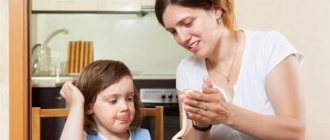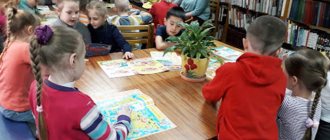Summary of a modeling lesson in the middle group on the topic “Flowers - unprecedented beauty”
Summary of a lesson in the middle group on modeling on the topic: “Flowers are of unprecedented beauty!”
Goals.
Learn to draw a flower from a thinly rolled flagellum, and petals and leaves from thick, short flagella and place it on a board for rolling out plasticine. Develop imagination, encourage creative initiative. Develop the ability to notice the beauty of nature.
Equipment:
flower in a vase, plasticine, stacks, napkins, doll, music screensaver.
Preliminary work.
Watch the presentation “Flowers”; while walking, pay attention to the beauty of flowers and their structure.
GCD:
Guys, today is our doll Dasha’s birthday. All the toys are going to visit her and now they are thinking about what to give her. And what do you think?
(children's answers)
Yes, you can give candies, jewelry, and toys. But all the girls love it when people give them flowers. And I prepared such a beautiful flower.
(showing the children a flower in a vase)
Let's look at the structure of a flower, what it consists of. Here is a stick with a flower on it – it’s called a stalk. Look, on the stem there is...tell me what they are called? (leaves) And above the stem, there are many petals and in the middle of each flower there is a round “eye”, and at the bottom there is a root, through which the flower feeds. Let's give our doll a big bouquet. Do you agree?
(children's answers)
Then I will show you how you can “grow” a flower from plasticine. Each flower has a stem, and we will roll it out into a thin flagellum of green plasticine. Then we roll out thick short flagella, which we press and attach to the stem on the left and right. Then we pinch off a small piece of plasticine for the “eye”; it will be yellow in color. Roll it into a ball, flatten it, and press it again to the top of the stem. What color will your flower petals be?
(children's answers)
Now watch how I will make petals from white, short “sausages”. I also flatten them and put them around the “eye”. So my beautiful flower is ready!
What flower does it remind you of?
(chamomile)
This is the flower I will give to Dasha’s doll. But one flower will not make a bouquet. There are still many flowers to “grow”. It's time to get down to business. Let's stretch our fingers.
Finger gymnastics “Flower”
Early in the morning it is closed (fingers pressed tightly together)
But it's getting closer to noon.
Opens the petals (fingers move apart, forming a circle. Inhale the aroma of the flower)
I see their beauty.
In the evening it closes its petals (we slowly connect our fingers. You can come up with the name of the flower)
He will sleep like a baby bird. (put your head on your closed hands and “fall asleep”)
I turn on the music. Along the way, I help children who are having difficulties.
You noticed how such beautiful flowers made our group even more elegant. I think they will greatly delight our birthday girl and decorate her room. Let's go give.
Artistic and aesthetic development (modeling) “Beautiful Flower” (middle group)
Publications on the topic:
GCD for the NGO “Artistic and Aesthetic Development”. Application “My mother is a spring flower” Teacher: G. R. Kiseleva Age of children: 3-4 years Topic of the week: “Our grandmothers and mothers” GCD: “Artistic and aesthetic development (application).”
Artistic and aesthetic development (sculpting) “Doctor Aibolit” Notes on artistic and aesthetic development (sculpting) “Doctor Aibolit” for the first junior group Purpose: to consolidate sculpting skills - pinch off.
Artistic and aesthetic development. Modeling: “Flight into space”, in the senior (speech therapy) group Purpose: To encourage children to create plot compositions. Develop the ability to use familiar sculpting methods in work: rolling, pulling, etc.
Summary of a modeling lesson on the topic “Vegetables” (senior group) 1. Program content: To consolidate the ability to convey the shape of different vegetables in modeling (carrots, beets, cucumbers, potatoes, pumpkins, tomatoes.
Abstract of the GCD “Blue, pure snowdrop-flower.” Speech and artistic-aesthetic development Abstract of GCD. “A blue, pure snowdrop is a flower.” Speech and artistic-aesthetic development. In the preparatory group. Educator.
Abstract of GCD on OO Artistic and Aesthetic Development. Modeling “Symbol of the Year - Monkey” Abstract of the educational field of the educational field “Artistic and Aesthetic Development” (modeling) in the preparatory group on the topic: “Symbol of the Year - Monkey”.
Summary of organized educational activities “Artistic and aesthetic development” (sculpting) “Striped zebra” Topic of the week: “Animals of hot countries.” “Striped Zebra” (summary of the organized educational field “Artistic and Aesthetic.
Consultation for teachers on the topic “Artistic and aesthetic development (sculpting)” 1 slide Title of presentation 2 slide The phrase modeling in kindergarten usually means visual activity in the course of.
Sand games. NOD in the NGO "Artistic and Aesthetic Development". Drawing “Flower for a Butterfly” (second group of early age) TASKS; To develop children's cognitive activity in the process of artistic creativity. Contribute.
Long-term planning “Artistic and aesthetic development Lepka. Application" preschool age group 3–4 years Date Lexical topic Topic, tasks. IOO Card file September 1 week Goodbye, summer, hello, kindergarten! Modeling Topic: “Acquaintance.
Bas-relief sculpture “The houseplant has bloomed”
Greeting game “Our smart heads”
Our smart heads will think a lot, cleverly. The ears will listen, the mouth will speak clearly. Hands will clap, Feet will stomp. Our backs straighten, we smile at each other.
Observing indoor plants
— Walking on the street now, you see a lot of flowers. But the cold will come, winter will come, and then you won’t see flowers on the street. And people always want to admire flowers - both in winter and in summer. So people came up with the idea of growing flowers in their houses, in the rooms where they live. And not only flowers, but also other plants. So they began to call such plants that are grown in the rooms of the house “houseplants.” Children look at violet, geranium and clivia. Attention is drawn to the presence of flowers, color, and shape of leaves. Geranium leaves can be disturbed and smelled, then explained that the plant is protecting itself in this way.
Didactic game “Come to the plant that I will name”
— Go to the tallest plant. This is geranium. Go to the shortest plant. This is a violet. Go to a medium-sized plant. This is clivia.
One, two, three, go to the violet! One, two, three, go to the geranium! One, two, three, go to the clivia!
Construction of “Flower in a Pot”
— Place geometric shapes in their place to make a flower in a pot. What geometric shapes does the pot consist of? From the square. How many squares? One. What geometric shapes is a flower made of? Circle and ovals. How many laps? One lap. How many ovals? Three ovals. What geometric figure is the stem made of? From a rectangle. How many rectangles? One rectangle. What geometric shapes are leaves made of? From Triangles. How many triangles? Two triangles.
Didactic game “Which plant is the leaf from?
- Look at these leaves and these plants and try to determine which plant each leaf fell from.
Didactic exercise “Arrange the flowers”
— Each pot has a number written on it. Arrange the flowers so that in each pot as many flowers bloom as the number written on this pot. How many flowers will bloom in a pot with the number “1”? One flower. And in a pot with the numbers “2” and “3”?
Didactic game “Match saucers to flower pots”
- Choose a saucer of the same color for each pot.
Drawing with Clivia paints
— Clivia has long thin leaves. Paint these leaves on this plant with a brush and green paint.
Bas-relief sculpture “The houseplant has bloomed”
“It’s time for the flowers to bloom on this indoor plant.” Let's make flowers for him ourselves using plasticine and these thread flowers. Roll out balls from plasticine, press them onto the picture with a houseplant, place a flower on top of the plasticine and press it down with your palm. Remove the flower and see what happens. Make more flowers for this indoor plant in this way.



